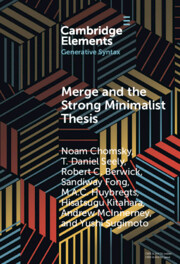Element contents
Merge and the Strong Minimalist Thesis
Published online by Cambridge University Press: 17 November 2023
Summary
- Type
- Element
- Information
- Series: Elements in Generative SyntaxOnline ISBN: 9781009343244Publisher: Cambridge University PressPrint publication: 14 December 2023
References
- 21
- Cited by

